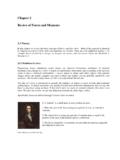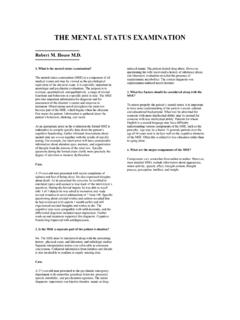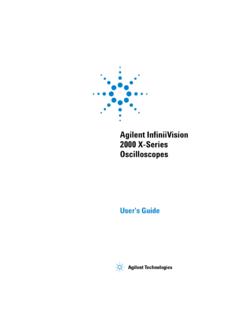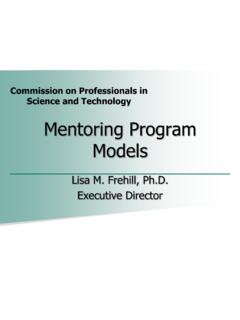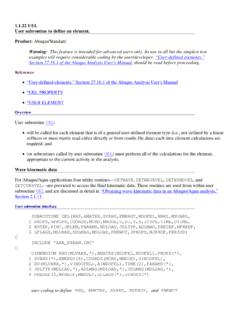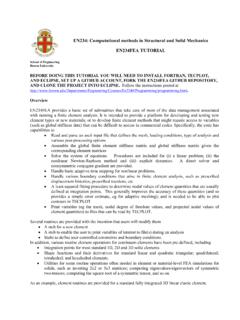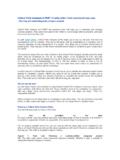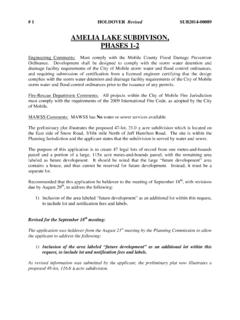Transcription of Amelia Blanford Edwards, 1831-1892 by Barbara S. Lesko
1 Amelia Blanford Edwards, 1831-1892 by Barbara S. LeskoAn American newspaper called her in 1889 "the most learned woman in the world" for her dexterity in writing, research, and public speaking. In England today she is called the god-mother of Egyptology, for her dedication to the Egypt Exploration Society, which she founded, and the Edwards Chair in Egyptian Archaeology, which she funded, at University College London. Amelia B. Edwards was an extraordinarily talented woman who excelled in music, art, writing, and public speaking. She was an early career woman who tried four different careers in her lifetime and never married. Amelia Edwards' talents were early recognized by her family, and she was encouraged as a child to be expressive and daring.
2 For the first forty years of her life she did seek adventure, even to the point of, like George Sand, dressing like a man and frequenting establishments off limits to ladies of her class in order to learn more of life and to find models for her drawing. Her career interests included music (voice and organ) at which she excelled and also art (drawing), which she eventually put to use as an illustrator for her books. She loved travel and would produce two of the most successful travel books of all time. In her youth a Bohemian who found her friends of both sexes among artists and writers, both in France and Britain, she was always a radical in politics, religion, and social thought. However, later she would suppress her beliefs and personal yearnings to become a successful writer and fund raiser for archaeology.
3 She published nine novels and many stories, including romances and ghostly tales, early in her career, but she was also a journalist on the staff of two magazines. During the last two decades of her life, Edwards devoted herself to Egyptology, not only fundraising and lecturing, but research and writing scholarly as well as popular articles. Amelia Edwards was born in London, June 7, 1831 to a middle aged couple, Alicia, an energetic and intellectual mother descended from the Walpoles, and Thomas, a retired army officer who had served under Wellington in the Peninsular War, but later in civilian life occupied a minor banking post. Young Amy was an only child on whom her mother doted and made sure she was given every cultural advantage affordable by a middle class family of the time.
4 Amy seems to have been born with a pen in hand, writing her first story at age four, and by twelve showing great promise in story writing and illustrating. A voracious reader too, as a child she delved into Wilkinson's Manners and Customs of the ancient Egyptians, but her first choice (in her mid-teens) was for a career in music, both voice and organ were her strengths. This was in a few years set aside, however, for a more lucrative path of writing. As the only child of old parents with modest means, Miss Edwards took up the responsibility of wage earner and during the1850-70's journalism was her profession, working on the staffs of two magazines, the Saturday Review and the Morning Post and contributing articles to even more.
5 She reported on current events of every sort, excepting the Houses of Parliament and police reports. During the 1850's she produced histories of England (London and Boston, 1857) and France (London, 1858). She also wrote nine novels and numerous short stories. Her first novel, My Brother's Wife was published in 1855 and was well received by critics. Four of her novels are still in enjoyed travel and spent much time in France and Italy. One of her sojourns in Italy, when she traveled with a wealthier single woman, resulted in her producing the highly successful Untrodden Peaks and Unfrequented Valleys (1873) about their hikes in the almost uncharted Dolomites. This book is still a classic for devotees of mountain climbing.
6 In the winter of 1873-74, due to inclement weather in Europe, with the same companion edward 's travel plans were changed to head for Egypt's sun and warmth. There the women hired a large houseboat and spent many weeks on the Nile. The result was not only the still popular Thousand Miles up the Nile, but a radical change in Amelia 's career. After her experiences in Egypt, on this one and only trip there, she sacrificed a successful writing career to devote herself exclusively to Egyptology and most of all to the cause of rescuing the ancient monuments and archaeological sites so that they might be studied before they were totally destroyed. Edwards had been appalled by the destruction and mutilation of antiquities and sites she had viewed, but she also found great enjoyments at hand.
7 Moored for two weeks at Abu Simbel, she discovered a small chapel in the temple of Abu Simbel which had been hidden in a sand dune. Bitten by the archaeology bug and also seized by the need to do something to quell the destruction of historical records, Amelia took up the challenge of alerting the world to the plight of ancient Egypt's legacy. "I am told that the wall paintings which we had the happiness of admiring in all their beauty and freshness (in the chapel she discovered at Abu Simbel ) are already much injured. Such is the fate of every Egyptian monument, great or small. The tourist carves it over with names and dates, and in some instances with caricatures. The student of Egyptology, by taking wet paper "squeezes" sponges away every vestige of the original colour.
8 The "Collector" buys and carries off everything of value that he can, and the Arab steals it for him. The work of destruction, meanwhile goes on The Museums of Berlin, of Turin, of Florence are rich in spoils which tell their lamentable tale. When science leads the way, is it wonderful that ignorance should follow?"Appearing in 1877, her A Thousand Miles up the Nile (with illustrations by her hand) was an instant success. In its writing she had corresponded with Egyptologists for information: Birch and Poole at the British Museum, Maspero in Paris, (who had read her novels and for whom she would translate some of his books, such as his Manual of Egyptian Archaeology). Her care for obtaining facts, her serious efforts in research and self-education (she learned to read hieroglyphs) set her apart from the other non-professional writers of the time whose approach was much more that of the dilettante.
9 Publicity of the plight of Egypt's monuments had to be followed by practical measures for their study and conservation. Apparently, it was Edwards who conceived the idea of an English organization to support archaeological work and publication in December, 1879, appeared a letter from the Swiss archaeologist Eduard Naville's letter in the Morning Post outlining the urgent need for foreign financial support for archeological exploration in Egypt, as Egypt itself was now bankrupt and archaeological work under the direction of the government's archaeologist August Mariette had stopped due to his ill health. This gave Edwards the ammunition she needed. Soon she was writing a number of scholars urging support and seeking funds by appealing to the then current interest in finding evidence to prove the Biblical stories were authentic.
10 Birch of the British Museum refused to help this effort, seeing no gain for England. Stuart Poole, keeper of coins and medals there was enlisted however, and Edwards and Naville combined forced and pushed ahead, writing Mariette of their plans to raise money for him. He soon died, but Gaston Maspero, already friends with Edwards, succeeded him, which boded well for the English. Birch did suggest, however, that an endowed teaching chair and preparation of future students was needed in London. Meanwhile Maspero asked Edwards if she might not find a young English archaeologist to excavate in Egypt. In 1882, the Egypt Exploration Fund was founded with Poole and Sir Erasmus Wilson, with Amelia Edwards taking subscriptions from Americans as well as the English.
